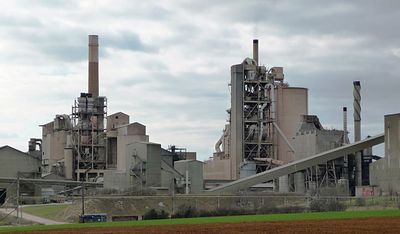Ketton Cement Kiln
| Ketton Cement Kiln | |
 See Cement Kilns → page for a larger UK Wide map. | |
| Waste Licence | BM0486IT |
| Operator | Hanson Cement |
| Parent Company | Heidelberg Cement Group |
| Clinker Capacity | 1.4 Mt |
Summary site information collated from a variety of sources.

Overview
WikiWaste has used the website Cement Plants and Kilns in Britain and Ireland[1] extensively for the reference material for each individual cement kiln page. The detail on this reference website is extensive and as WikiWaste is focused upon the UK waste and resource market, only the key highlights are captured from this website (and company websites accordingly) to provide background and context. Ketton started manufacturing clinker in 1929 and up to 2015 had produced 56 million tonnes of clinker through 8 rotary kilns over this period.
Ownership
- 1929 to 1986 Ketton Portland Cement Co. Ltd (owned by Thomas W Ward and Co Ltd to 1981, then Rio Tino Zinc (RTZ))
- 1986 to 2009 Castle Cement Ltd (RTZ to 1989, Scancem to 1999, HeidlebergCement to 2009)
- 2009 to Present Hanson Cement UK (owned by HeidelbergCement)
The Process at Ketton
The process at the site is similar to that at Cookstown - a 'semi-dry process' from kiln supplier Polysius (part of the ThyssenKrupp group).
Raw Materials
The primary raw materials are Great Oolite and Yellow Inferior Oolite Limestone, with Great Oolite Shale and Upper Lias Shale all from the same nearby quarry.
Waste Used on Site
The Ketton site waste return to the EA for the most recent year showed the following wastes used on site:
| Waste Class | Description | Tonnage Input |
|---|---|---|
| 02 02 02 | animal-tissue waste | 25 |
| 10 01 02 | coal fly ash | 4,921 |
| 19 02 08* | liquid combustible wastes containing dangerous substances | 18,408 |
| 19 09 02 | sludges from water clarification | 2,590 |
| 19 12 10 | combustible waste (refuse derived fuel) | 40,181 |
| 19 12 12 | other wastes (including mixtures of materials) from mechanical treatment of wastes other than those mentioned in 19 12 11 | 40,201 |
Around 90% of the tonnage listed was used for the primary purpose of substituting fuel requirements in the plant, with coal fly ash (also called Pulverized Fuel Ash or PFA) used as a replacement for raw material in the production process. Hanson intend to 'continuously increase' the use of alternatives as part of their 2030 commitments[2].
